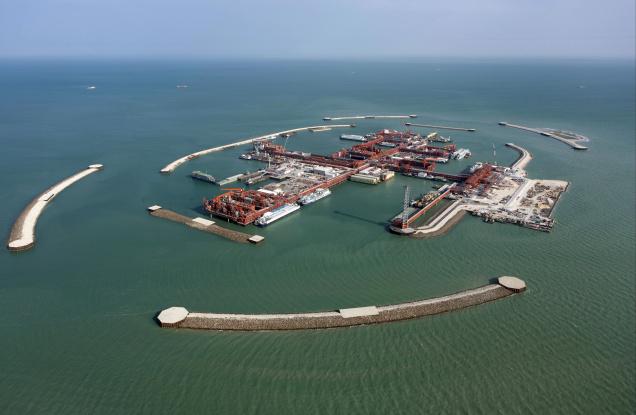
Mixed Views of China’s “One Size Fits All” Trade Diplomacy in Central Asia
Publication: China Brief Volume: 13 Issue: 22
By:

President Xi Jinping’s latest, highly ambitious tour through the Central Asian republics took regional political circles by surprise. From the points of view of Central Asian capitals, it seems clear that Beijing is marching through Moscow’s turf in Central Asia, forging close ties by offering more money and less meddling compared with the Kremlin’s often troublesome integration schemes. However, the cordial ties between Beijing and Central Asian regimes stand in sharp contrast to popular attitudes to China. Local media, opposition groups and popular opinion are often skeptical of China’s rising presence in Central Asia. While there is variation among the region’s post-Soviet republics, certain themes reappear—concern about the inflow of Chinese labor, disputes about land and territory and skepticism about the management of commercial deals.
The people of these countries experience opportunities merged with anxiety and antagonism. Reactions also vary between states, as variations between governments and policies produce different levels of engagement with China, and thus different experiences and attitudes among populations at large. This article illustrates how elites and people in the region configure their views and attitudes toward China’s economic clout, as well as why and how that is happening in each state and in the whole region.
Nascent anti-Chinese sentiments have turned violent in some countries in the last few years, most often via hostility toward Chinese migrants. The popular movement "Protect Kyrgyzstan" in the Kyrgyz Republic, founded by a former speaker of the parliament, aimed to halt illegal migration of workers from China and to confront “ravenous” Chinese business practices, the subject of which flared into a public campaign in Kyrgyzstan organized by the "Free People" faction with the support of the Kyrgyz language media (Gezitter, July 10; 24kg, February 21). Similar discontent exists in neighboring Tajikistan, where The Islamic Renaissance Party and the “Homeland” popular movement oppose China’s influence in the country (Ariana.su, March 23, 2012).
Domestic authorities, however, have welcomed China as a rising economic superpower in Central Asia. Clearly, it has much to offer them, both economically and as an alternative to what regimes view as political meddling by more established regional powers—the United States and Russia. As Uzbek President Islam Karimov has happily remarked, "In 22 years of bilateral relations between Uzbekistan and China, the latter has never set any political demands" (Asia Times, September 24).
Presidents and ruling elites see Beijing as offering a lifeline for their political survival against domestic rivals and external threats. For these elites, Chinese cash inflow and massive development projects help to solidify an image of capable leadership and sound economic management. (Liter, June 13; Centrasia.ru, January 24, 2008). Central Asian regimes also see China as a wall against Western demands for human rights and democracy. The essentially China-led Shanghai Cooperation Organization (SCO) legitimizes and protects authoritarian regimes on the world stage as following a “distinctive way of development” (Kremlin.ru, July 5, 2005). The SCO’s struggle against the “three evils” of terrorism, separatism and extremism, suits the primary interests of the Central Asian regimes by creating space to neutralize domestic opponents.
China also offers a welcome alternative to Russia’s paternalism. As Russia’s integration plans in post-Soviet Eurasia have provoked a sense of anxiety in the region (see Eurasia Daily Monitor, June 5 and 12; November 6), Chinese President Xi Jinping has repeatedly stressed China’s respect for Central Asian sovereignty (Xinhua, September 13). China’s hunger for energy deals, and its willingness to put them ahead of political questions, has undermined Russia’s ability to use economic coercion.
Regimes cannot afford to antagonize Russia, but they have on several occasions turned to China for support against its demands, especially in disputes over energy. For example, Turkmen authorities have been successful in developing energy projects with China, freeing it from pressure from GazProm. Turkmenistan has favored a Chinese-sponsored gas pipeline from Turkmenistan’s Galkynysh gas reserve through Uzbekistan, Tajikistan and Kyrgyzstan, integrating Central Asian states (Platts Oilgram, September 4). Likewise, former Kyrgyz President Kurmanbek Bakiyev, prior to his overthrow, responded to Russian meddling in Kyrgyz affairs by offering Kyrgyz-Russian joint infrastructure projects to Chinese businesses (Vesti.kz, January 14, 2010).
Nevertheless, regional elites retain strong cultural and political ties with Moscow. Kazakhstan, Kyrgyzstan and Tajikistan have joined Moscow’s Collective Security Treaty Organization, and have moved toward its proposed customs bloc and Eurasian Union. Cooperation with China is also limited by popular discomfort about China’s power, economic influence and physical presence via infrastructure projects and migrant labor.
Domestic poll results about attitudes to China’s presence in the region vary between countries, and appear to be heavily influenced by the relative presence or absence of free speech, political pluralism and independent media. Polls in the relatively free societies of Kyrgyzstan, Kazakhstan and Tajikistan reveal conflicting public opinions about China’s emergence in the region (Pravda.ru, August 15). The political opposition in these republics often use criticism of "Chinese expansion" to challenge regimes. In relatively authoritarian Uzbekistan and Turkmenistan there is no reliable public opinion polling, making it hard to comment on popular attitudes.
The largest source of domestic opposition in Kyrgyzstan and Tajikistan is the inflow of the Chinese labor. In Kyrgyzstan and Tajikistan, an upsurge of Chinese laborers has escalated competition with local communities for jobs in mining, agriculture, construction, trade and transportation. Consistent increase in the number of Chinese small and medium businesses in both states is breeding anger among Kyrgyz, Uzbek and Tajik commercial associations and local communities (Fergana.ru, November 30, 2007). Uniquely, Uzbekistan has set up a strict visa regime to limit migration while welcoming Chinese investment. In wealthier Kazakhstan and Turkmenistan, where Beijing is heavily involved in energy sectors, migrant labor has not been a major issue.
There is no records of violence against Chinese companies or their employees in Uzbekistan and Turkmenistan, where authoritarian regimes may have simply suppressed hostility, while President Nursultan Nazarbayev’s regime in Kazakhstan tolerates anti-Chinese sentiments by applying preventive measures to stem off aggressive behavior. In the weaker states of Kyrgyzstan and Tajikistan, violent skirmishes with Chinese workers, attacks on Chinese companies and assassinations of Chinese businessmen occur frequently.
Sporadic clashes between Chinese workers and local residents have been on the rise in Tajikistan over the last five years, driven both by migration and Chinese acquisition of land in the country (Institute For War and Peace Reporting, November 28, 2007). The Tajikistani labor migration service’s statistics have reported increasing flows of Chinese workers since 2007. By 2010, their estimated population in Tajikistan had reached 82,000. Tajik communities were enraged in 2011, when the government leased 2,000 hectares of farmland to China, a week after a decision to cede 1,100 square kilometers of disputed land along the Chinese border (Radio Free Europe/Radio Liberty [RFE/RL], January 28, 2011).
There is a widespread perception in Central Asia that China encourages migration in order to reduce the pressure of overpopulation, and to settle groups of Chinese nationals who can influence the politics of Central Asian countries. Tajikistani expert Rustam Haidarov asserted that "It is China’s strategy to resettle its people in different countries. It’s China’s policy. They occupy slowly, cautiously. They realize their own goals in Tajikistan and affect our economic policy. In time this will lead to influence in politics" (RFE/RL, January 28, 2011). Muhtar Auezov, the former Kazakhstani ambassador to China, has described the "massive presence" of Chinese nationals in Kazakhstan as a result of its "fundamental issue of overpopulation" (Megapolis.kz, August 5).
Trade and infrastructure agreements also generate skepticism and resentment in Central Asian countries, as opposition groups question the ability of governments to negotiate and manage deals in the national interest. Kazakhstan’s relations with Beijing are a case in point: Astana has most succeeded in allaying popular concerns about dependence on China, but has done so by promising to limit China’s involvement in the country’s energy sector. Kazakhstan’s minister of oil and gas promised in September that China’s share of the domestic oil and natural gas production will drop from 24 percent to 7-8 percent (Kapital, November 6). Independent industry experts predict that China will keep its stake in the republic’s oil and gas sector between the ranges of 20 to 30 percent—and $5 billion June deal in which CNPC took over an 8.7% share of Kazakhstan’s largest oil field, Kashagan, from ConocoPhillips strong suggests that China’s energy presence in the country is still growing (Kapital, November 6; Bloomberg, June 28). This assessment suggests the likelihood of tensions as China continues to press for more energy deals with the nation.
In Kyrgyzstan, nationalist factions, youth organizations and opposition groups claim that the Chinese foothold in the country is an imminent threat to national interests. A series of high-publicized scandals implicating Chinese businessmen in bribery and corruption have fed public sensitivity over business dealings with China (24kg, May 7; 24kg, July 3; Eurasianet, October 31, 2012). While many Kyrgyz political analysts and economic experts have positive views of Chinese energy and infrastructure investment overall, they have been frequently critical of the government’s management. For example, the Bishkek-based 24kg news agency’s examination of the terms of the commercial contract between Chinese power transmission manufacturer Tebian Electric Apparatus and the Kyrgyz government concluded that it had violated procurement laws (24kg, November 7). Other experts, such as public adviser Azamat Akeleyev, caution that Kyrgyzstan is taking on large debts from China that will have to be repaid soon (24kg, September 13).
More generally, critics of the Kazakstani government describe it as naive and subject to manipulation by Chinese diplomats. Former ambassador to China Muhtar Auezov says that Kazakhstan lacks experts on Chinese internal and external politics, leaving Astana clueless over Beijing’s long term stratagem in the country and Central Asia. He is also skeptical of the current ability of the Kazakh foreign intelligence services to analyze Chinese intentions toward Kazakhstan across the board, stressing Astana’s ongoing disadvantage on critical issues as trans-boundary water resources, currently efficiently exploited by Chinese leadership. (Megapolis.kz, August 5) Similar viewpoints are often expressed by Kazakh liberals and nationalists (Tengrinews, May 24, 2011).
As Deirdre Tynan of the International Crisis Group observes, “Central Asian governments see China as a wealthy and willing partner, but on the ground little is being done to ease tensions between Chinese workers and their host communities” (The Economist, September 14). The authoritarian polities of the region, as well as China’s preference for focusing its diplomacy on small groups of elites, combine to create neglect of local public outreach programs, creating controversies that may limit further economic integration. In spite of these challenges, President Xi Jinping’s visit demonstrated Beijing’s determination to improve public relations efforts in the region and to expand positive perceptions of China. More importantly, dynamic trade with China and Chinese business advancements in Central Asia have boosted domestic economies, and over the long term this may help to resolve local skepticism and pave the way for deeper economic integration.
UPDATED ON 11/8/2013





